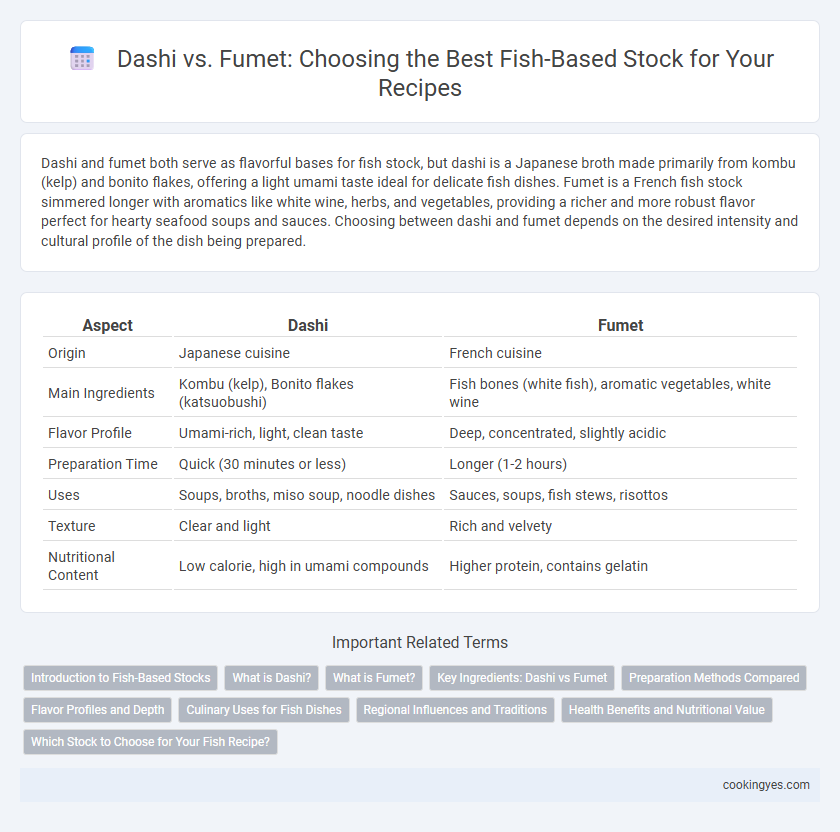Dashi and fumet both serve as flavorful bases for fish stock, but dashi is a Japanese broth made primarily from kombu (kelp) and bonito flakes, offering a light umami taste ideal for delicate fish dishes. Fumet is a French fish stock simmered longer with aromatics like white wine, herbs, and vegetables, providing a richer and more robust flavor perfect for hearty seafood soups and sauces. Choosing between dashi and fumet depends on the desired intensity and cultural profile of the dish being prepared.
Table of Comparison
| Aspect | Dashi | Fumet |
|---|---|---|
| Origin | Japanese cuisine | French cuisine |
| Main Ingredients | Kombu (kelp), Bonito flakes (katsuobushi) | Fish bones (white fish), aromatic vegetables, white wine |
| Flavor Profile | Umami-rich, light, clean taste | Deep, concentrated, slightly acidic |
| Preparation Time | Quick (30 minutes or less) | Longer (1-2 hours) |
| Uses | Soups, broths, miso soup, noodle dishes | Sauces, soups, fish stews, risottos |
| Texture | Clear and light | Rich and velvety |
| Nutritional Content | Low calorie, high in umami compounds | Higher protein, contains gelatin |
Introduction to Fish-Based Stocks
Dashi and fumet are essential fish-based stocks used in culinary traditions to impart rich umami flavors to dishes. Dashi, a Japanese stock, typically combines kombu (kelp) and katsuobushi (bonito flakes), offering a light yet deeply savory foundation ideal for soups and broths. Fumet, a French fish stock, is traditionally made by simmering fish bones, aromatics, and white wine, producing a more concentrated and gelatinous base suited for sauces and refined seafood preparations.
What is Dashi?
Dashi is a traditional Japanese fish-based stock made primarily from kombu (kelp) and katsuobushi (dried bonito flakes), providing a delicate umami flavor essential in Japanese cuisine. Unlike fumet, which is a concentrated French fish stock made by simmering fish bones with mirepoix and aromatics over a longer period, dashi is quickly prepared to preserve the subtle flavors of its ingredients. Dashi serves as the foundational broth in dishes like miso soup, clear soups, and noodle broths, emphasizing clean, balanced fish notes without overwhelming heaviness.
What is Fumet?
Fumet is a concentrated fish stock made by simmering fish bones, heads, and aromatic vegetables, often enhanced with white wine and herbs for deeper flavor. It is typically clearer and more refined compared to traditional fish broths, commonly used in classical French cuisine for sauces and soups. Fumet provides a rich umami base, intensifying the taste of delicate fish dishes without overpowering their natural flavors.
Key Ingredients: Dashi vs Fumet
Dashi, a traditional Japanese stock, is primarily made from kombu (kelp) and katsuobushi (dried bonito flakes), offering a delicate umami flavor ideal for light, fish-based dishes. Fumet, a French fish stock, is crafted by simmering fish bones, white wine, vegetables, and aromatic herbs, providing a richer, more robust base suited for hearty seafood sauces and soups. The key distinction lies in dashi's minimalist use of dried ingredients versus fumet's complex, slow-cooked combination of fresh components enhancing deep flavor depth.
Preparation Methods Compared
Dashi is traditionally prepared by soaking kombu seaweed and simmering bonito flakes, creating a clear, umami-rich broth ideal for delicate fish dishes. Fumet involves simmering fish bones with aromatic vegetables like onions, carrots, and celery for an extended time, producing a more robust, gelatinous stock used in hearty seafood stews. Both stocks highlight different preparation methods that influence flavor intensity and clarity in fish-based recipes.
Flavor Profiles and Depth
Dashi delivers a delicate umami flavor derived from kombu seaweed and bonito flakes, enhancing fish dishes with subtle, savory complexity. Fumet offers a richer, more concentrated taste using fish bones, aromatic vegetables, and white wine, providing a deeper, more robust base ideal for hearty seafood soups and sauces. Choosing between dashi and fumet depends on the desired intensity and depth of flavor in the final fish dish.
Culinary Uses for Fish Dishes
Dashi and fumet both serve as flavorful bases for fish dishes, but dashi, made from kombu and bonito flakes, imparts a delicate umami ideal for Japanese soups and simmered fish. Fumet, a concentrated French fish stock simmered with white wine, vegetables, and herbs, enhances the richness of sauces and poached seafood dishes. Chefs choose dashi for subtle, clean flavors and fumet for robust, savory profiles in fish-based culinary applications.
Regional Influences and Traditions
Dashi, a fundamental Japanese fish stock made from kombu seaweed and bonito flakes, embodies the delicate umami flavors central to East Asian cuisine, emphasizing subtlety and balance. Fumet, a classic French fish stock crafted by simmering fish bones with mirepoix, white wine, and herbs, reflects the rich, robust flavors valued in Western culinary traditions. Regional influences shape these stocks, with dashi highlighting simplicity and clarity in flavors, while fumet prioritizes depth and complexity, each complementing their respective fish-based dishes.
Health Benefits and Nutritional Value
Dashi and fumet are both fish-based stocks that offer distinct health benefits and nutritional profiles. Dashi, a traditional Japanese stock made from kombu and bonito flakes, is rich in umami compounds and low in fat and calories, providing essential amino acids and minerals such as iodine. Fumet, a French fish stock prepared by simmering fish bones and aromatics, contains higher collagen levels and minerals like calcium and magnesium, supporting joint health and bone strength.
Which Stock to Choose for Your Fish Recipe?
Dashi, a Japanese fish stock made from kombu (kelp) and bonito flakes, offers a light, umami-rich flavor ideal for delicate fish dishes like sashimi or miso soup. Fumet, a French fish stock made by simmering fish bones, vegetables, and white wine, delivers a richer, more robust taste suitable for hearty fish stews or sauces. Choosing between dashi and fumet depends on the desired flavor intensity and culinary tradition of your fish recipe.
Dashi vs Fumet for Fish-Based Stock Infographic

 cookingyes.com
cookingyes.com